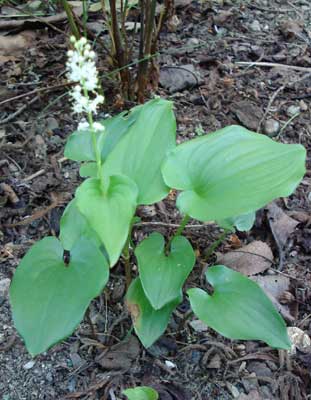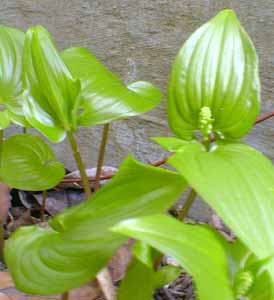
False or Wild
Lily-of-the-Valley; aka:
Snakeberry,
Deerberry,
Deer Heart,
Mayflower or May Lily
"O mother dear, when I was thine
Fine flowers in the valley
You did na prove to me sae kind
And the green leaves they grow rarely."
-Scottish ballad,
traditional
traditional
False or Wild Lily-of-the-Valley (Maianthemum dilatatum synonymous with M. kamtschaticum) is a common local wildflower, native from subarctic Alaska through the Yukon & British Columbia, throughout Washington & Oregon.
 The range is even more extensive, in that it crosses from Alaska to Russia, & grows along the Asian coast as far south as Korea, & in Japan, where it is called Maizurusou, "Russian Mouse."
The range is even more extensive, in that it crosses from Alaska to Russia, & grows along the Asian coast as far south as Korea, & in Japan, where it is called Maizurusou, "Russian Mouse."Ours was given to us by friends who dug a piece of it from along a salmon stream that passes through their property. Because it can be aggressive in a garden, we initially planted it in a spot hemmed in by sidewalk & concrete staircase, having been told that it was not inconceivable that its rhizomes might eventually be able to cross under the width of the sidewalk to escape its confinement (even with a "worst case scenario" I didn't envision it ever being burdensome; it is only apt to take over if never tended or weeded back).
But instead of spreading & filling in this harsh area, it barely hung on for dear life, & after a couple years I took pity on it & moved it to the best-tended main shade garden. It's gotten prettier as a result but it'll take two more years in its new spot before I might have to start rooting some of it up.
European Lily-of-the-Valley (Convallaria majalis) is likewise invasive & can escape the garden, seeding through the countryside, competing with native plants. So it is nice to have this closely related twin that is actually native to our county. Many regions have a locally native wildflower of similar character & appearance, & it should be sought instead of the all-too-commonly gardened but troublesome European species.
False Lily-of-the-Valley is common in the Rainforest here on the Olympic Penninsula, from near sea level to subalpine heights. It's often seen in extensive patches along streambanks. Despite this preference for moist locations, it even so becomes drought-hardy in the garden when its roots are well established, & is a good plant for dryish shade.
It will of course do best with regular watering, it can go prematurely dormant if too droughty, completely vanishing in summer. This does no injury to its spring reappearance.
It will thrive in much deeper shade than most shade plants, so it very nicely fills in those deep-shade areas where even most shade plants would be starrved for sunlight. The one fault we've experienced is the same as for hostas: slugs & leaf-chomping caterpillars can devour them into lacy fragments.
The second photo shows its March buds, which will open mid April through May into upright racemes of scented white flowers; the first photo at top shows it in May. The lush heart-shaped leaves reach only about ten inches high, with limitless potential for spread.
Late-summer & early autumn bright red berries add to its ornamental strengths. These were eaten fresh or dried by Northwest first peoples, although never highly regarded for flavor.
The Haida called them Frog Berries. They were usually picked a little green & were either dried right away, or stored in water until they ripened to red. They were then boiled, mixed with other mediocre berries such as from salal or snowberries, & mashed into cakes to be sun-dry for later use.
If not properly prepared, however, every part of the plant, including the berries, are very toxic, so I wouldn't risk even the traditional Haida recipe personally.
A number of myths, largely Christian in nature, are told about the European Lily-of-the-Valley. When Europeans arrived in North America, they transferred the common name & its legends to the several look-alike plants they encountered here.
A typical flower-myth has it that the tears of the Virgin Mary turned to Lilies-of-the-Valley as she wept at the foot of the cross, hence the white flowers of Her purity are sometimes called Our-Lady's-Tears. Another legend has them springing from the blood of St. Leonard the Dragon-fighter, who waged war against a dragon throughout the Vienne Valley. Wherever the dragon's blood spilled, poisonous vines erupted, but wherever St. Leonard's blood was spilled, Lilies-of-the-Valley arose.
Such myths date further back than Christianity, however, for Apuleius makes it sacred to Apollo, & the European species is quite rightly named majalis after the Pleiades goddess Maia, mother of Hermes (Mercury). This was carried over even to the False Lily-of-the-Valleys for which the genus name Maianthemum translates literally "Maia's Blooms," she for whom May is named.
Anything once associated with Maia & Hermes was ineveitably significant plants in alchemical science or sorcery, & old astrological books place Lily-of-the-Valley under the dominion of Mercury.
Pioneers of course considered the False Lily of the Valley not to Maia's bloom, but called M. dilatatum, M. racemosum, M. canadense & similar North American look-alikes "Mary's Flower." For it was inevitable that myths of such figures as Maia & Hermes were easily transferred (in the New World as easily as in Europe) to Mary & Jesus, who asked his followers to be like unto the lilies of the field.